 (『エクセル☆サーガ』六道神士)
(『エクセル☆サーガ』六道神士) (『ダンジョン飯』九井諒子)
(『ダンジョン飯』九井諒子)「コツコツ」や「カツカツ」は、硬い床での足音です。
"Tricks" and "tricks" are footsteps on hard floors.
 (『Beast of East』山田章博)
(『Beast of East』山田章博)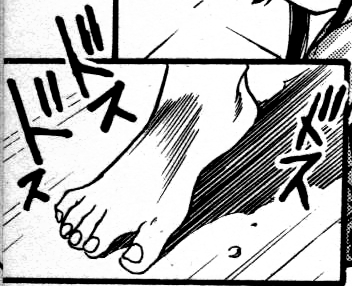 (『幻蔵人形鬼話』高田裕三)
(『幻蔵人形鬼話』高田裕三)「だんだん」や「ドスドス」は荒々しい足音です。
"Dandan" and "Dosudosu" are a rough footstep.
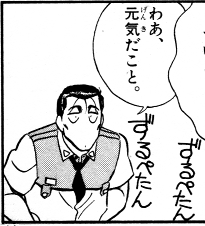 (『機動警察パトレイバー』ゆうきまさみ)
(『機動警察パトレイバー』ゆうきまさみ) (『機動警察パトレイバー』ゆうきまさみ)
(『機動警察パトレイバー』ゆうきまさみ)「ずるぺたんずるぺたん」と「ぺたんぺたん」は、ゴムスリッパの足音です。
"ZuruPetanzuruPetan" and "Petanpetan" are footsteps of rubber slippers.
 (『機動警察パトレイバー』ゆうきまさみ)
(『機動警察パトレイバー』ゆうきまさみ)「カンカンカン」は鉄製の階段を上り下りしている音です。
"Kankankan" is the sound of going up and down iron stairs.
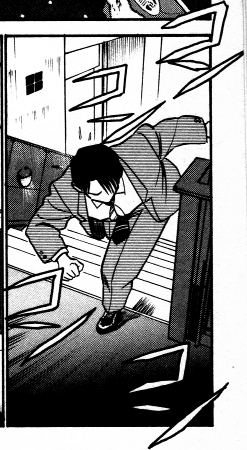 (『機動警察パトレイバー』ゆうきまさみ)
(『機動警察パトレイバー』ゆうきまさみ)この「コンコンコン」は、コンクリート製の階段を革靴で上り下りするときの音を表しています。
This "conconcon" expresses the sound of going up and down a concrete staircase with leather shoes.
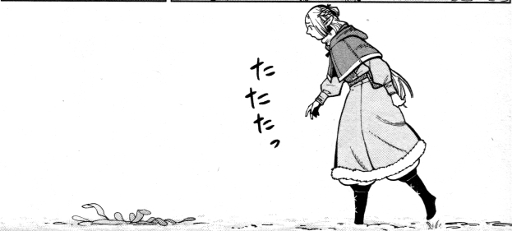 (『ダンジョン飯』九井諒子)
(『ダンジョン飯』九井諒子)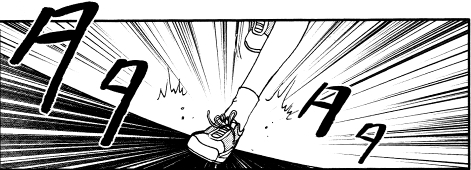 (『機動戦士ガンダムさん』大和田秀樹)
(『機動戦士ガンダムさん』大和田秀樹)「たたた」は少し早めの足音です。
"Tatata" is a slightly earlier footstep.
 (『エクセル☆サーガ』六道神士)
(『エクセル☆サーガ』六道神士)「ダダダ」は全力で走っている場合の足音です。
"Dadada" is the footstep when running at full power.
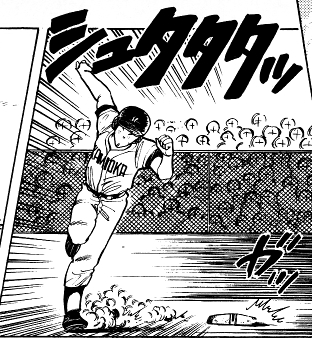 (『ヒューマンリーグ』斉藤むねお・野沢尚)
(『ヒューマンリーグ』斉藤むねお・野沢尚)「シュタタタ」はとても早い走りを表しています。
"Shutatatata" represents a very fast run.
日本人は「シュ」に速さを感じます。
Japanese people feel speed in "shu".
 (『かみちゅ!』鳴子ハナハル)
(『かみちゅ!』鳴子ハナハル)この「だっ」は、走り始めです。
This "da" is starting to run.
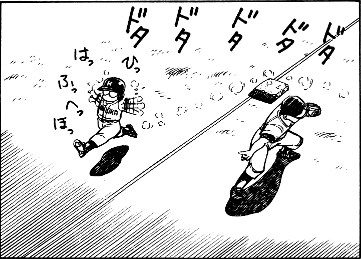 (『ヒューマンリーグ』斉藤むねお・野沢尚)
(『ヒューマンリーグ』斉藤むねお・野沢尚)「ドタドタ」は下手な走り方です。
"Dadota" is a poor run.
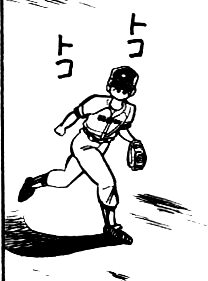 (『ヒューマンリーグ』斉藤むねお・野沢尚)
(『ヒューマンリーグ』斉藤むねお・野沢尚)「トコトコ」は歩きと走りの中間くらいの早さで、軽やかなステップです。
"Tokotoko" is a light step that is about halfway between walking and running.
 (『ヒューマンリーグ』斉藤むねお・野沢尚)
(『ヒューマンリーグ』斉藤むねお・野沢尚)「とっとことー」は、元々は「とっとことっとこ」で、「とことこ」よりさらに軽快なステップです。
"Tottokoto-" is originally "Tottokotottoko" and is a lighter step than "Tokotoko".
 (『トニーたけざきのガンダム漫画』トニーたけざき)
(『トニーたけざきのガンダム漫画』トニーたけざき) (『かみちゅ!』鳴子ハナハル)
(『かみちゅ!』鳴子ハナハル)「ドドド」は大勢が走っているときの足音です。
"Dododo" is the footstep when a large number of people are running.
人でも動物でもロボットでも同じです。
The same applies to humans, animals and robots.
歩きの状態を表すオノマトペもあります。
There is also onomatopoeia that indicates the state of walking.
 (『エクセル☆サーガ』六道神士)
(『エクセル☆サーガ』六道神士)「テクテク」は足音ではなく、「敢えて歩く」という意味です。
"Tekuteku" is not footsteps but means "dare to walking".
ただし、マンガで用いられる場合は単に「歩いている」という意味だけの場合があります。
However, when used in MANGA, it may just mean “walking”.
 (『さすがの猿飛』細野不二彦)
(『さすがの猿飛』細野不二彦)「すたすた」は、早く歩いていることを表すオノマトペです。
"Sutasuta" is an onomatopoeia that means walking fast.
 (『MISTER ジパング』椎名高志)
(『MISTER ジパング』椎名高志)「つかつか」は、迷わずまっすぐ迫ることを表すオノマトペです。
"Tsukatsuka" is an onomatopoeia that expresses a straight approach without hesitation.
 (『エクセル☆サーガ』六道神士)
(『エクセル☆サーガ』六道神士)「ずんずん」は、勢いがあって迷いのない歩きのことです。
"Shunshun" is a walk that has momentum and no doubt.
 (『機動警察パトレイバー』ゆうきまさみ)
(『機動警察パトレイバー』ゆうきまさみ)「うろうろ」は、歩き回るという意味です。
"Urouro" means walking around.
 (『機動警察パトレイバー』ゆうきまさみ)
(『機動警察パトレイバー』ゆうきまさみ)「のっしのっし」は、大柄な者が悠然と歩く様子を表すオノマトペです。
"Noshinoshi" is an onomatopoeia that shows a large person walking calmly.
しかし、この例では不機嫌そうに歩き回っている様子に使われています。
However, in this example, it is used to look sullen.
 (『砂ぼうず』うすね正俊)
(『砂ぼうず』うすね正俊)「こそこそ」は、だれかに見られないように静かに行動することです。
"Kosokoso" means acting quietly so that no one can see you.
機械翻訳では「sneak」と訳されます。
In machine translation, it is translated as "sneak."
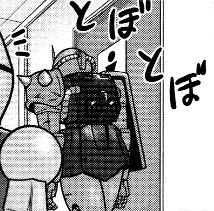 (『機動戦士ガンダムさん』大和田秀樹)
(『機動戦士ガンダムさん』大和田秀樹)「とぼとぼ」は、彼が失意などによって弱々しい歩き方になっていることを表しています。
"Tobotobo" indicates that he is walking weakly due to disappointment.
 (『機動警察パトレイバー』ゆうきまさみ)
(『機動警察パトレイバー』ゆうきまさみ)「どやどや」は、大勢の人間が騒がしく出入りしている様子を表すオノマトペです。
"Doyadoya" is an onomatopoeia that shows a lot of people coming and going noisy.
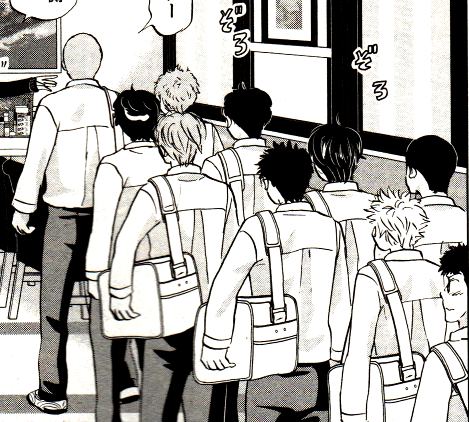 (『おおきく振りかぶって』ひぐちアサ)
(『おおきく振りかぶって』ひぐちアサ)「ぞろぞろ」は、大勢が列になっている状態です。
"Zorozoro" is a state where many people are in a line.
元々は動いていない場合にも使われたようですが、現在は動いている場合にのみ使われます。
Originally used when not moving, but currently only used when moving.
大勢が動かずに列になっている場合には「ずらずら」が使われます。
If a large number of people are in a row without moving, "Zurazura" is used.